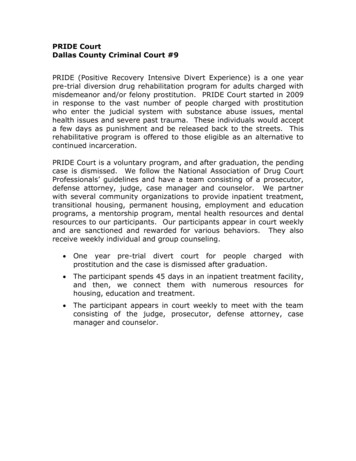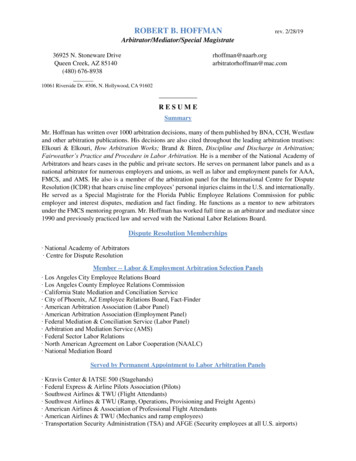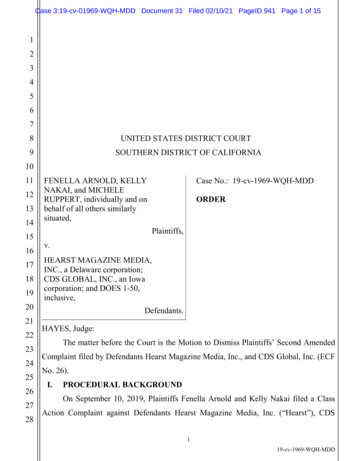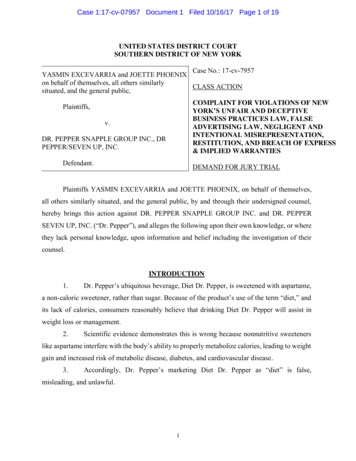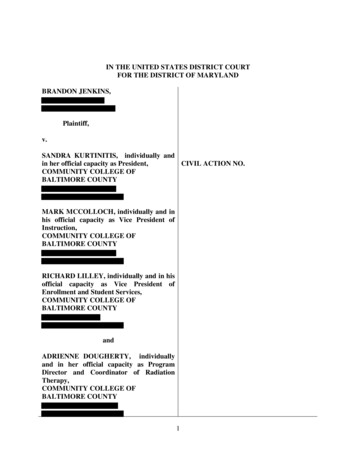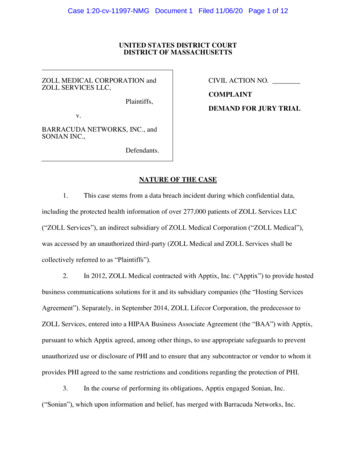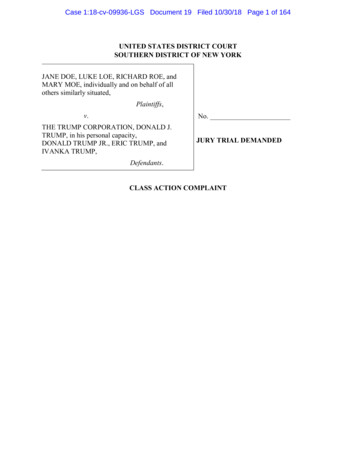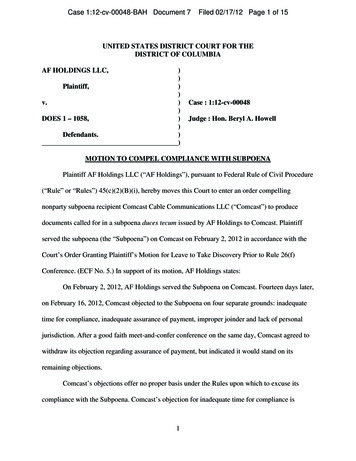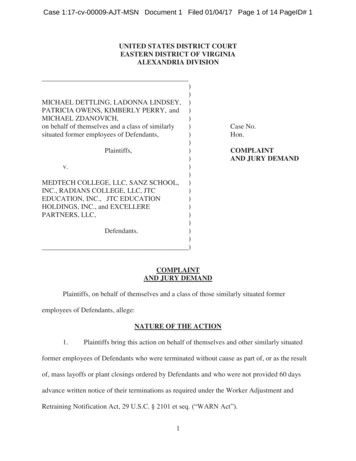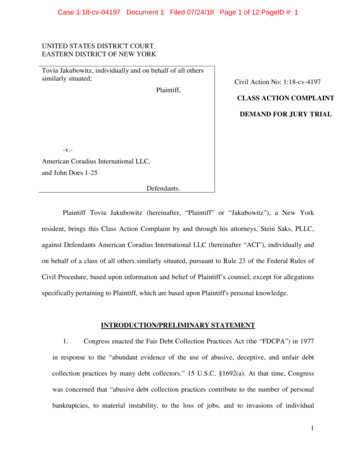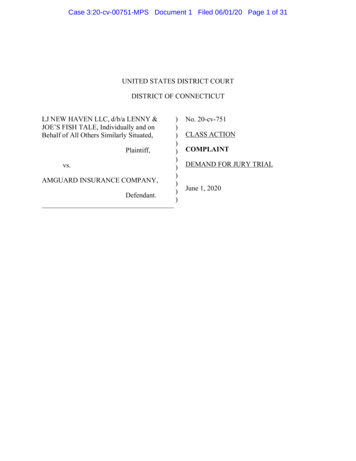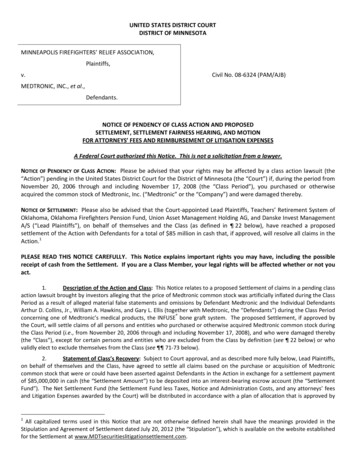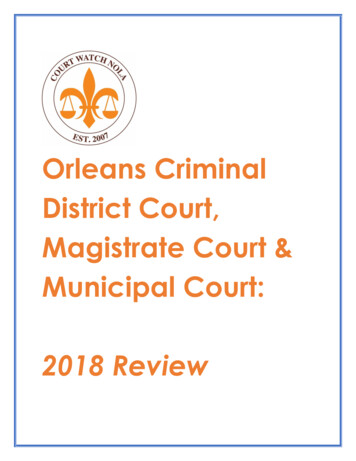
Transcription
Orleans CriminalDistrict Court,Magistrate Court &Municipal Court:2018 Review
TABLE OF CONTENTSI. Executive Summary. 3II. Introduction . 12III. Methodology . 13IV. Judicial Ethics & Conflicts of Interest in Orleans Parish Criminal Courts. 15A. Campaign Finance . 15B. One-Party Sidebars. 24C. Intolerance & Prejudice . 27V. Victim Rights . 29A. Victims in Magistrate Court . 30B. Untreated Crime Victim Trauma . 32C. The Traumatized Victim and Testimony in Court. 35VI. Bail, Fines, and Fees. 40A. The Return on Indictment Process . 40B. Municipal Court Bail Reform . 50C. Drug Test and Other Court Fees . 52VII. Incarceration and Other Sanctions . 55A. Contempt . 551. Contempt for Failure to Hire a Private Attorney . 562. Contempt for a Positive Drug Screen Test . 63B. Guilty Pleas for Incarceration and Habitual Offender Status . 69C. Marijuana Cases . 71VIII. Efficiency. 74IX. AcknowledgEments . 772
I . EXECUTIVE SUMMARYCourt Watch NOLA (CWN) is a non-profit organization with the mission of promoting reform in theOrleans Parish criminal court system through civic engagement and courtroom observation. Thisreport encompasses the data collected and the observations made by 113 CWN volunteers fromJanuary 1, 2018 to December 31, 2018 in Criminal District, Magistrate, and Municipal Courts with atotal of 810 court settings observed. This report explores the topics of conflicts of interest, victimrights, bail, right to counsel, fines and fees, criminal contempt, pre-trial drug testing and efficiencyin the Orleans Parish criminal courts and the larger criminal justice system during 2018.Judicial Ethics--Campaign FinancingThe Code of Judicial Conduct teaches judges that, in order for the community to retainconfidence in them, the judge must not only be independent and honest but just as importantly,the judge must be believed by all to be independent and honest. 1 In examining campaigncontributions from 2008-2018, CWN found that Judge Paul Bonin received a 1,000 campaign loanfrom ETOH Monitoring, LLC (“ETOH”) executives in his successful 2016 election2 and at least 8,150in campaign financing from ETOH monitoring executives over the last ten years. 3 Judge Bonin wasfound to have steered defendants to the ETOH for ankle monitoring in 23 cases. On severaloccasions, Judge Bonin refused to release the defendants from jail until the defendant’s familyhad arranged for ETOH to establish ankle monitoring services. 4 On several other occasions, JudgeBonin refused to release criminal defendants from their ankle monitors until the defendant paidETOH all remaining fees the defendant owed to ETOH. In at least two cases, Judge Boninthreatened to incarcerate the defendant for failing to pay ETOH. In 2018, ETOH’s ankle monitoringcost approximately 10 a day, and Judge Bonin often required criminal defendants to wear anklemonitors for months. Recommendation 1: Judges should avoid conflicts of interest that reflect adversely on thejudge’s impartiality, interfere with the proper performance of the judge’s duties, or exploitthe judge’s judicial position. Judges should not accept campaign funds and loans thatmight reasonably appear as influencing the judge’s official conduct or undermining thejudge’s independence, integrity, or impartiality. Where it is impossible for a judge to avoida conflict of interest, it is incumbent upon the judge to disclose the conflict of interest tothe relevant parties to avoid the impression of impropriety.See Leslie Abramson, Canon 2 of the Code of Jud. Conduct, 79 Marq. L. Rev. 962 (1996).La. Ethics Admin. Program, La. Campaign Fin. Rep. No. 59725 for Paul Bonin (8/10/16).3 La. Ethics Admin. Program, La. Campaign Fin. Rep. No. 61852 for Paul Bonin (1/19/17); La. Ethics Admin. Program, La.Campaign Fin. Rep. No. 60688 for Paul Bonin (11/4/16); La. Ethics Admin. Program, La. Campaign Fin. Rep. No. 35430 forPaul Bonin (2/15/13); La. Ethics Admin. Program, La. Campaign Fin. Rep. No. 32109 for Paul Bonin (8/8/12); La. Ethics Admin.Program, La. Campaign Fin. Rep. No. 804529 for Paul Bonin (10/4/08).4 Court Transcript transcribed by Stenographer Eve Kazik, Criminal District Court Section D., Case No. 542162, (Oct. 24,2012).123
Judicial Ethics--One-Party SidebarsFrom 2016 until present, CWN has tracked one-party sidebars, the discussion between the judgeand either the defense or the prosecution without the opposing party present, conducted at thebench or in judicial chambers, and outside the earshot of the public. According to the JudicialCanons, a judge shall not permit private or ex parte interviews, arguments, or communicationsdesigned to influence their judicial action in any case.5 These ex parte sidebars often occur duringone-party sidebars. In fact, one the best way we have to reduce back-room dealings betweenthe powerful players of our system and judges is by reducing the ex parte meetings that areevidenced in one-party sidebars. Recommendation 2: Where a one-party sidebar is absolutely necessary for administrativereasons, judges should announce to the public that the facts of a case are not beingdiscussed or that the matter being discussed is purely administrative. Judges shouldattempt to discontinue the practice of one-party sidebars since it gives a public impressionthat undermines confidence in the judge’s independence, integrity, and impartiality.Judicial Ethics--Intolerance and PrejudiceCanon 3 of the Code of Judicial Conduct states in part, “A judge shall perform judicial dutieswithout bias or prejudice. A judge shall not, in the performance of judicial duties, by words orconduct manifest bias or prejudice, and shall not permit staff, court officials or others subject tothe judge's direction and control to do so.”6 In 2018, CWN volunteers observed 16 incidents inMagistrate Court, 11 incidents in Criminal District Court, and one incident in Municipal Court wherethe CWN volunteer perceived someone in the court “was treated inappropriately or differentlybased on gender, race, ethnicity, religion, age, disability status, sexual orientation, or economicstatus,” with racial prejudice being the most common type of perceived discrimination. Permittinga public official to openly engage in discrimination encourages the public to believe thatdiscriminatory attitudes, statements, and actions are acceptable, normal, and thus can beemulated and even escalated.7 Recommendation 3: Judges should refrain from any action or statement that could givethe impression of bias against a defendant or other individual in their courtroom based ongender, race, ethnicity, religion, age, disability status, sexual orientation, or economicstatus. Judges have the responsibility of ensuring that prejudice and bias are not toleratedby the lawyers and court staff in the judge’s courtroom.La. Code Jud. Con. § 3(A)(6) (2019).La. Code Jud. Con. § 3 (2019).7 Brian Levin & John David Reitzel, Cal. State University, San Bernadino Ctr. for the Study of Hate & Extremism, Rep. to theNation: Hate Crimes Rise in the U.S. Cities and Counties in Time of Division & Foreign Interference (May 2018),https://csbs.csusb.edu/sites/csusb . See also Anti-DefamationLeague, strategies/pyramid-of-hate-en-espanol (last visited Mar. 9,2019).564
Victim Rights--Victims in Magistrate CourtSince March 2018, assistant district attorneys no longer appear for 14 out of 19 Magistrate Courtsettings. That means there is no assistant district attorney making bail arguments, speaking on thevictim’s behalf, or speaking to victims in Magistrate Court in more than ⅔ of Magistrate Courtsettings. Often, crime victims have pivotal information about the defendant’s likelihood ofreturning to court and their likelihood of committing new crimes upon pre-trial release.8 Withoutthe prosecutor in Magistrate Court, the victim has lost a pivotal opportunity to transmit whetherthe defendant poses a danger to them or anyone else in the larger community. Recommendation 4: The Orleans Parish District Attorney’s Office should regularly attendand take part in all first appearance hearings in Magistrate Court. When crime victims haveinformation that relates to the defendant’s pre-trial release, the prosecutor should ensurethat such information is transmitted to the Magistrate or Commissioner who is determiningpre-trial release.Victim Rights--Untreated Victim TraumaExperts in the victim advocacy field have concluded that a more effective response to victimtrauma will reduce repeat victimization and future offending. 9 Crime victims with untreatedtrauma can exhibit aggressive, retaliatory behaviors and/or engage in illicit substance use, allleading to increased rates of arrest.10 When CWN volunteers were asked to record the number ofMagistrate Court cases where the defendant could also potentially be considered the victim of acrime, CWN volunteers found that in 77% of cases, the defendant may have been defendinghimself or herself from another individual. 11 Despite the well-documented correlation betweenchronic exposure to trauma and an increased rate of arrest, 12 the Louisiana Crime VictimReparation Board is currently prohibited from providing resources to any non-sex crime victim whohas been convicted of a felony in the last three years before becoming a crime victim, or anycrime victim who is currently on probation or parole.13 Louisiana House Bill 85 would eliminate theInt’l Ass’n of Chiefs of Police Victim Services Comm., Law Enforcement's Role in Supporting Victims' Needs Through Pretrial Just. Reform (June 2015), 8/SupportingVictimsThroughpretrialReform.pdf (“If the standard procedure for determining pre-trial release is consistently informed by the results of a riskassessment and testimony provided by the victim(s), as opposed to a static bond schedule, better informed decisionscan be reached. Institutionalizing this practice also helps meet the need of victims to be heard throughout the justiceprocess”).9 Jeremy Travis, Summoning the Superheroes: Harnessing Sci. & Passion to Create a More Effective & Humane Responseto Crime: 25th Anniversary Keynote Address, in The Sentencing Project, To Build a Better Crim. Just. Sys.: 25 ExpertsEnvision the Next 25 Years of Reform, 5-13 (Marc Mauer & Kate Epstein eds., 2012), available tem.pdf.10 Lena Jäggi et al., The Relationship Between Trauma, Arrest, and Incarceration History Among Black Ams.: Findings fromthe Nat’l Survey of Am. Life, 6 Society and Mental Health 187-206 (2016).11 N 26 observations of Magistrate Court.12 Deborah Prothrow-Stith, The Promise of Prevention: Public Health as a Model for Effective Change, in The SentencingProject, To Build a Better Criminal Justice System: 25 Experts Envision the Next 25 Years of Reform, 28-29 (Marc Mauer &Kate Epstein eds., 2012), available at .pdf.13 Alysia Santo, For Black Crime Victims with Criminal Records, State Help is Hard to Come by, The Marshall Project &Reveal from the Ctr. for Investigative Reporting, U.S.A. Today, Sept. 13, 2018, available 83002/.85
prohibition against providing resources to crime victims and their families who have beenconvicted of a crime or who are currently on probation or parole.14 Recommendation 5: State political leaders and the community at large should supportLouisiana House Bill 85 and eliminate the discriminatory prohibition against crime victimsreceiving crime victim compensation when such victims have a criminal conviction or areon probation or parole.Victim Rights--The Traumatized Victim and Testimony in CourtThe majority of crime victims do not report the crime they are victimized by, and many othersdecide not to proceed with criminal charges after reporting. 15 In Louisiana, crime victims andwitnesses who are under 17 years of age or who are developmentally disabled can testify inanother room outside of the court and be simultaneously televised by closed-circuit television tothe court and jury.16 There is nothing in either federal or Louisiana State Law that limits the abilityof an equally-traumatized adult victim or witness from being able to testify via closed-circuittelevision if an important public policy requirement is present and the defendant is unable toreliably testify without a closed-circuit television.17 CWN volunteers tracked the number of times afragile victim or witness either testified or was asked to testify in criminal court. Out of a total ofseven observations, CWN volunteers indicated that no Judge offered a confidential space (i.e.,not the public courtroom) where the victim or witness could testify. Fragile victims or witnessesobserved by CWN volunteers included three victims of non-sexual offenses, two survivors of sexcrimes, and two witnesses with mental or emotional disabilities. Recommendation 6: The Louisiana State Legislature should consider amending LouisianaStatutes § 15:283 to allow an adult victim or witness to testify via simultaneous televisedtestimony (1) if expert testimony shows the victim or witness would likely suffer seriousemotional distress, and (2) without such simultaneous televised testimony, the victim orwitness could not reasonably communicate their testimony to the court or to the jury.Where possible, the Orleans Parish District Attorney should consider making a motionrequesting such a traumatized adult victim or witness be able to testify via closed-circuittelevision if expert testimony establishes that trauma had such a debilitating effect on thevictim or witness and the reliability of the victim or witness’ testimony is otherwise assured.H.B. 85, 2019 H. Legis. Servs., Reg. Sess. (La. 2019), available d 1116146.15 Judith Lewis Herman, The Mental Health of Crime Victims: Impact of Legal Intervention, 16 Journal of Traumatic Stress159-166 (2003), available at %3A1022847223135.16 La. Stat. Ann. § 15:283(A)(1)(2).17 Meg Garvin, et al., Allowing Adult Sexual Assault Victims to Testify at Trial via Live Video Tech., in Nat’l Crime Victim LawInst. Viol. Against Women Bulletin, 1 (2011), available at ual-assaultvictims-to-testify. See also Natalie Montell, A New Test for Two-Way Video Testimony: Bringing Maryland v. Craig into theTechnological Era, 50 U. Louisville L. Rev. 361, 373 (2012).146
Bail, Fines, and Fees--The Return on Indictment ProcessAfter the grand jury returns a “true bill” and a felony case is brought to the Criminal District Courtfor the first time, for at least 10 years if not longer18 it has been the practice of the District Attorney’sOffice to argue for a bail increase without notifying the defense, without the defense attorneypresent, without the defendant present, and without a written motion. The average bail amountincreased by 577% between Magistrate Court and Criminal District Court, from an average of 165,103 in Magistrate Court to an average of 1,117,472 after the true bill indictment was filed inCriminal District Court (the return on indictment). This amount decreased by only 6%, or anaverage of 64,037, after the defense attorney had an opportunity to reargue bail, ultimatelyaveraging 1,053,435. Sometimes criminal defendants who had already paid their bail wererearrested in criminal court without notice, even though they had followed all the conditionedrequirements of their bail bond release. Constitutional law requires the defense attorney to bepresent when bail is argued at a return on indictment. The defendant himself or herself should alsobe present in court for this proceeding if the prosecution chooses to argue for a bail increase. Recommendation 7: The defendant and the defense attorney must be notified andproduced, respectively, for any bail argument; a bail argument should not be an ex parteproceeding. When a defendant is “charged at large,” they should be arrested andbrought to the arraignment proceeding where bail can be set if needed. Judges shouldnot entertain a bail argument without the defendant and the defense attorney present;the defendant’s presence can only be waived for the bail argument by their attorney orby the defendant’s voluntary failure to appear. Commendation 1: CWN commends Chief Judge Keva Landrum-Johnson for ensuringconstitutional rights are upheld in her court during the return on indictment process. Shehas been courageous in prohibiting an unsound practice from continuing in hercourtroom, persuasive toward others on the bench to abide by the Constitution, andtransparent with the public.Bail, Fines, and Fees--Municipal Court Compliance with the2017 Municipal Bail Reform LawIn January 2017, New Orleans City Council passed comprehensive bail reform for all municipal(city) offenses. The municipal bail reform statute requires that a defendant charged only withmunicipal offenses and having no warrants19 or additional pending cases be released on theirown recognizance (with no bail)
rights, bail, right to counsel, fines and fees, criminal contempt, pre-trial drug testing and efficiency in the Orleans Parish criminal courts and the larger criminal justice system during 2018. Judicial Ethics--Campaign Financi
